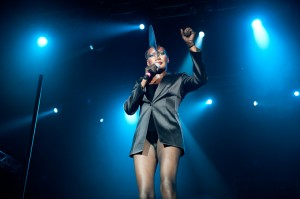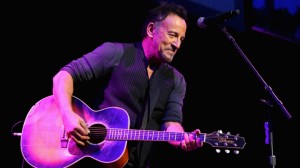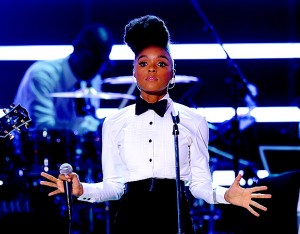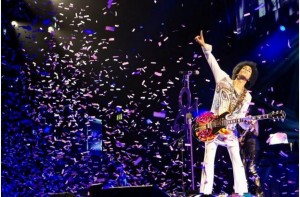Last week, The Music Of series held two concerts at Carnegie Hall, dedicated to celebrating the music of David Bowie. The Music Of series is a yearly charity event that celebrates the music of a different songwriter each year; it was scheduled months in advance and was planned as just another entry in the series. After his passing in January, though, the event became a celebration of the life of David Bowie as well as his music, and the most recent in a line of tribute performances celebrating the same. From nationally televised awards shows, to late night talk shows, to just some dudes on a stage of a bar in Brooklyn, there have been a slew of these, some brilliant, some confusing, some heart wrenching, and some underwhelming. Deadshirt staffers Julian Ames and Mike Pfeiffer were at one of the Music Of shows, and got to thinking about who they’d want to see at a Bowie tribute show. So they rounded up Dylan Roth, and the three of them made their lineup for the Ultimate David Bowie Tribute Concert.
The Artist: Gerard Way
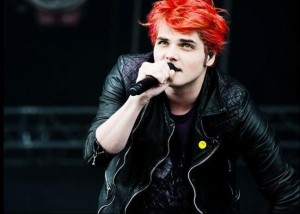
The Cover: “Five Years”/”Diamond Dogs”
The influence of David Bowie on Jersey-born rock idol Gerard Way has only become more obvious as his career has gone on. It may not have been terribly apparent in the early days of My Chemical Romance until the opening track of their third album The Black Parade. The Black Parade kicks off with the mournful “The End,” which borrows its tone and chord progression from “Five Years,” the first song on Bowie’s breakout The Rise and Fall of Ziggy Stardust and the Spiders from Mars. I imagine Way beginning his contribution to our show alone on the piano, crescendoing from a faithful bare-bones arrangement into a full band power ballad, much in the way MCR built on “The End,” and just where “The End” would kick into the high-voltage “Dead” on The Black Parade, Way and company launch into “Diamond Dogs,” the track most responsible for inspiring MCR’s following record, the post-apocalyptic concept album Danger Days: The True Lives of the Fabulous Killjoys. – Dylan
The Artist: St. Vincent

The Cover: “Scary Monsters (And Super Creeps)”
Honestly, it’s kind of a crime that St. Vincent hasn’t already done a song at one of these Bowie tribute events. She incorporates so much of his spirit into the things she does; from his theatricality, his sexuality/androgyny, to his ever forward musical direction, St. Vincent embodies all that and more–she may be the closest thing we have to another Bowie. “Scary Monsters” might be a left-field choice for a tribute concert, but St. Vincent is a left-field musician and the song really mirrors the kind of manic energy that she has in her songs. Plus, she fucking shreds and would totally nail Robert Fripp’s guitar parts. – Julian
The Artist: Grace Jones w/ Carlos Alomar
It’s not hard to see David Bowie’s thumbprint on an artist. Androgyny, musical experimentation, the kind of cheekbones that can be used to slice cheddar. Grace Jones can never be accused of being unoriginal, but it’s immediately clear that David Bowie left a profound impression on her. She covered “Nightclubbing,” a track Bowie cowrote with Iggy Pop, on her album of the same name. Where better to put her than on the dark mirror to “Golden Years”: “Fashion,” from Scary Monsters. Grace Jones’s singular presence is another one of the most frequently recurring images in fashion next to Bowie, and her spare, intense style would be well applied to the sinister undertones of “Fashion” as well as fellow dancefloor satire “DJ.” Carlos Alomar is one of David Bowie’s most prolific collaborators, and his chops are to thank for so much of the funk and soul that filled Bowie’s ’70s and ’80s work (in addition to having co-written “DJ”). Bringing him on with Grace would ground her performance while giving her space to make it her own. – Mike
The Artist: Bruce Springsteen w/ Ronnie Wood
“Why does Bruce Springsteen get to play one of his own songs?” Because David Bowie loved it, that’s why. At the time he covered it with Ronnie Wood in the sessions for Diamond Dogs, Bruce and the E Street Band had recently put out Greetings from Asbury Park, NJ – a critically lauded but commercially underperforming debut album that owed its mythmaking feel and dizzying lyricism to the work of Bob Dylan. David Bowie has one of those, too, and it’s not hard to see why he was an early champion of The E Street Band’s combination of ’50s rock, ’60s folk, and outsized poetry. The protagonist of “Growin’ Up” switches identities, bucks conformity, and ultimately becomes “The cosmic kid in full costume dress,” a line which should erase any lingering doubt as to whether this song belongs here. No reinterpretation necessary, just bring Bowie’s friend and collaborator Ronnie Wood onstage to play the licks. – Mike
The Artist: Sharon Jones & the Dap-Kings
While there are plenty of artists out there doing interesting new things with the genre, Sharon Jones is probably the best classic-style soul singer alive. (Her label-mate Charles Bradley is a strong contender, too.) “Changes” is a very versatile pop song that lends itself to a variety of interpretations, and I’d love to hear Jones and her band slow it down a pinch and turn it into a big brassy soul ballad. Backed by the Dap-Kings and her longtime backup singers Saun & Starr, Sharon Jones could make this a showstopping number even if thrown into a show between much better-known artists. – Dylan
The Artist: LCD Soundsystem
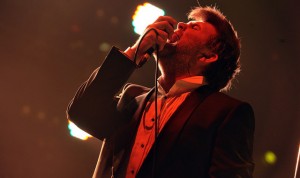
The Cover: “Station to Station”/”Golden Years”
Station to Station the album, for me, wasn’t one of the Bowie records that I really remembered that well, nor was it one of the ones I listened to that often. I was a late-comer to LCD Soundsystem–discovering them just as they announced their break up–but I quickly became a pretty big fan. On my first relisten of Station to Station since my discovery, I was struck by how much the opening title track sounded like a precursor to some of LCD‘s ideas. It’s no secret that James Murphy is a huge Bowie fan, even name-checking him in lyrics, and he was able to collaborate with his hero on his last two albums: remixing The Next Dayi’s “Love is Lost” into the “Hello Steve Reich” mix and playing percussion on a few songs on Blackstar. With LCD Soundsystem reuniting, I think it’s only natural to have them on this bill, and even more natural to have them cover this song. I threw in “Golden Years” because “Station to Station” is a deep cut, and audiences at these tribute shows want artists to (forgive the pun) shut up and play the hits, so I figure they could go right into the next song on the album without missing a beat. – Julian
The Artist: Janelle Monae w/ Gail Ann Dorsey
“Young Americans” is one of the best products of Bowie’s obsession with soul music in the ’70s, and the effervescent, enigmatic Janelle Monae is one of the names most floated as the heir to Bowie’s legacy, with her history of concept albums and distinctive fashion. Not every decision is hard. Gail Ann Dorsey worked with David from Earthling through The Next Day, touring with him extensively and lending her unique presence and outstanding voice to new interpretations of classics like “Rebel Rebel” and “Let’s Dance.” Whether played straight or pushed into excesses of funk, together they could pay tribute to David and to the music that he loved. – Mike
The Artist: Muse
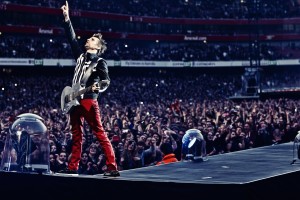
The Song: “Cat People (Putting Out Fire)”
As Mike Pfeiffer illustrated beautifully in a piece we ran last year, David Bowie was a pretty damn brilliant science fiction writer, constructing what Mike calls “sonic b-movies.” Matthew Bellamy and Muse also inject cosmic-level doom into their stadium rock, often walking on the razor’s edge of becoming impenetrable prog rock but rarely tumbling into the starry abyss. Muse, despite technically being a three-piece band, puts on one of the loudest, biggest stage shows this side of Pink Floyd. Just imagining what these incredible musicians could accomplish on “Cat People” with Bellamy’s impossibly elastic voice and about a quarter-million dollars worth of special effects makes my head spin. (Could you imagine insuring this concert?) – Dylan
The Artist: Kanye West
As he infamously proclaimed at his Glastonbury set, he is the greatest living rockstar on the planet, so it’s only right to have him pay tribute to one of his predecessors. Say what you will about Kanye’s ego or personality or whatever, the man has taken many cues from Bowie’s career, and would probably admit as such if asked. A constant pioneer in both music and fashion, Kanye just needs to start acting to check all the Bowie boxes. He channels Bowie even in his stage show and performances. Remember the giant lighted mountain of the Yeezy tour? What about the red suit and pharaoh chain (or just about anything else) of the My Beautiful Dark Twisted Fantasy era ? I guess I already said this about St. Vincent, but “the closest thing to the next Bowie” title might actually belong to Kanye. “Fame” is a pretty appropriate song for him to take on, I’m sure he can relate to the sentiment of the song. Because it’s Kanye, I wouldn’t expect a direct cover of the song, nor would I want one, honestly. Kanye would take the track, chop it up, add his own lyrics, maybe throw in something from his own track, “Famous;” he might even bring in his own guest (Bowie had Lennon, maybe Kanye could have Kendrick or The Weeknd). – Julian
The Artist: Annie Lennox and Kevin Barnes w/ Mick Garson
At the Carnegie Hall show, one of the most affecting moments was a stripped down reimagining of “Ashes to Ashes,” hauntingly executed by Michael Stipe and Karen Ellson. “Life on Mars?” is straight up the most beautiful song ever written, and that melody alone could float a zeppelin. It deserves to live on its own merit, probably played by yet another of Bowie’s prolific collaborators, Mike Garson. Annie Lennox’s performance with David at the Freddie Mercury tribute in 1992 was a legendary torch passing, and Lennox could do the same to avante garde Glamkeeper Kevin Barnes of Of Montreal. – Mike
The Artist: Prince
Prince and Bowie have so much in common that it’s almost like they’re the same guy from two parallel Earths. They’re both hugely influential and prolific singer-songwriters multi-instrumentalists, and hypersexualized androgynous music and fashion icons, and there isn’t a huge pool of people who fit into the center of that contrived venn diagram. After Bowie’s death, Prince performed “Heroes” live with Nile Rodgers, but if you ask me, “Modern Love” is the perfect Bowie song for the Purple One. It’s a little funky, it waffles between huge and sparse, and it’s right in the sweet spot of Prince’s lower vocal register, with room for him to do some acrobatics during the outro. (Nile Rodgers is, of course, still invited.) – Dylan

